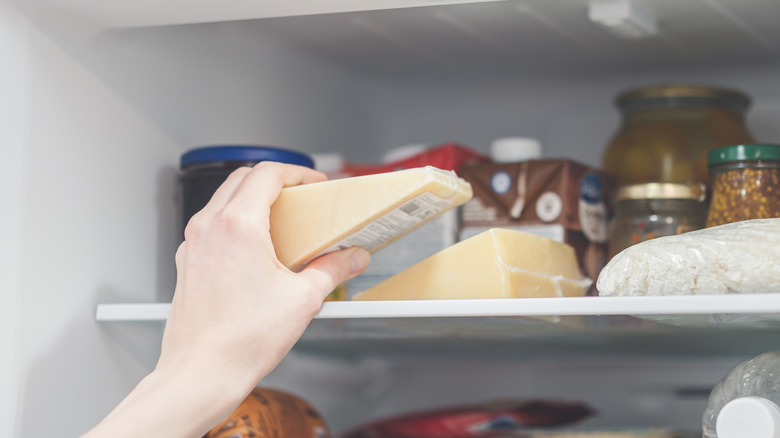How To Thaw Frozen Cheese For The Freshest Flavor And Best Texture
We may receive a commission on purchases made from links.
We love cheese, but it's not cheap! A well-crafted charcuterie board with an array of cheeses is a delight, but when you've got a $20 hunk of Gruyère left over, you don't want to waste it. Even the world's most expensive cheese won't last forever. The good news? Cheese can be frozen. The catch? It has to be thawed properly to keep it from turning into a sad, crumbly mess.
For the best results, patience is key. Cheese should always be thawed slowly in the refrigerator. Pop it into an airtight container or keep it in its original wrapping, then let it sit in the fridge for at least 12 hours to come back to life — overnight is even better. This gradual defrosting helps retain its texture and moisture, preventing it from becoming overly crumbly or dry.
Avoid the temptation to speed things up! Thawing cheese at room temperature (please, no) or in the microwave might save time, but it can cause the fats and proteins to separate, leaving you with an oily, unappetizing disaster. Once thawed, try to use your cheese within a couple of days.
Best practices for freezing and thawing cheese
Not all cheeses freeze equally. Hard and semi-hard cheeses — think cheddar, Swiss, provolone, parmesan and mozzarella — will likely hold up best. Their lower moisture content makes them less prone to major texture changes. Don't freeze hard cheeses with rinds, though — the rind could give everything an unpleasant taste if frozen. Soft cheeses like Brie, ricotta, cream cheese, or fresh goat cheese? Freezing turns them grainy, watery, and just pretty gross, and we wouldn't recommend it. Try making creamy gnocchi with your leftover ricotta, or read our 14 ways to use leftover cream cheese to avoid waste instead! Shredded cheese can also freeze and thaw well, if you package it with as little air as possible and thaw for at least 24 hours in the fridge.
To freeze cheese properly, portion it first. Wrap it tightly in wax paper or plastic wrap, then seal it in an airtight bag. The less oxygen, the better your results. Try using an affordable vacuum sealer to get all the air out, like this Megawise Vacuum Sealer from Amazon. After it's thawed, your cheese won't taste exactly the same as it did before, but it should be pretty close! Because of this, we'd recommend using it in salads, melting into mac and cheese, or grating it up rather than trying to eat it plain.
Bottom line: Freeze wisely, thaw slowly, and enjoy your cheese without the waste!

